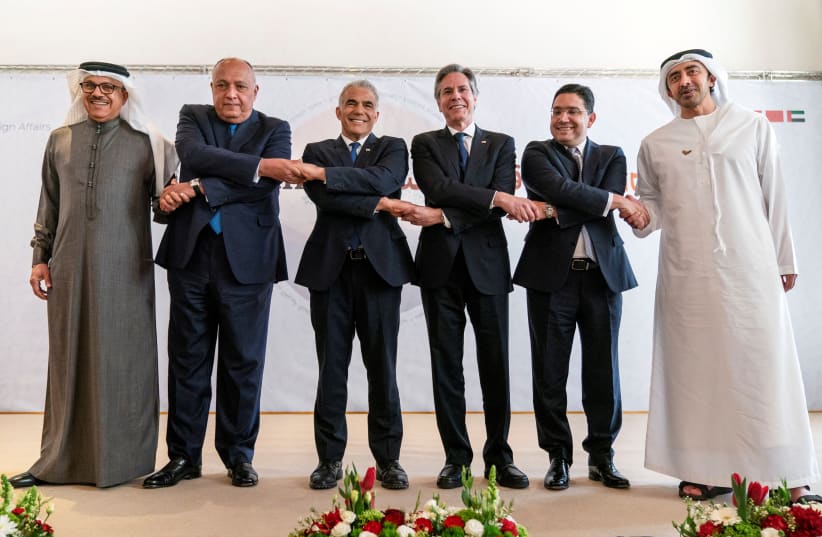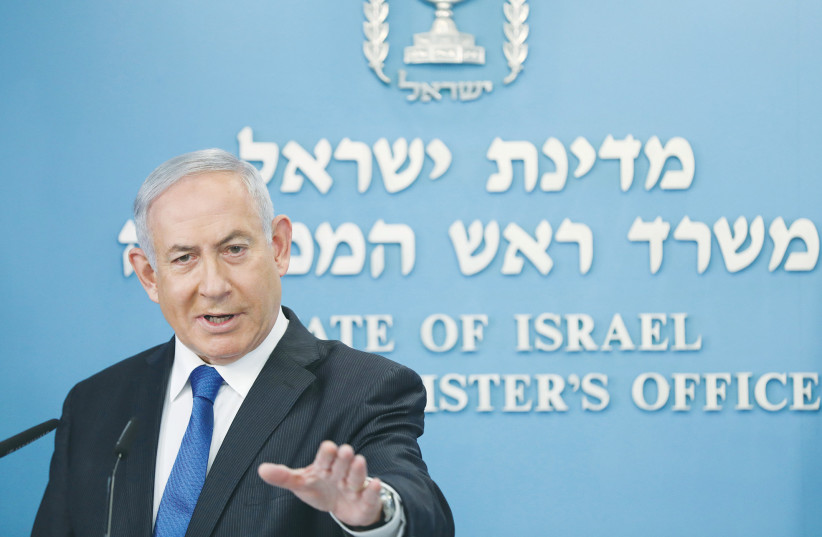Two years ago this week, the surprise announcement of Israel-UAE normalization heralded the advent of the Abraham Accords. A month later, I was at the White House to witness the signing of peace agreements with both the Emirates and Bahrain. By the end of the year, Sudan officially joined the process and Morocco upgraded its ties with Israel.
These 2020 breakthroughs were emblematic of a historic shift away from the old Middle East with its unremitting and omnipresent Arab-Israel conflict.
As late as 1990, former US secretary of state James Baker still witnessed firsthand the priority given across the region to the Palestinian issue. At the time, even though the Arab Gulf states desperately sought US military protection in the aftermath of Saddam Hussein’s invasion of Kuwait, America nonetheless had to commit to a new push for Arab-Israeli peace as a prerequisite for assembling the 35-country anti-Saddam coalition.
But if the topic of Israel-Palestine was once a guaranteed agenda item whenever a Western president or prime minister spoke to an Arab leader, the current century saw a revolution in Arab strategic thinking.
Many were initially oblivious to the changes. They occurred under the radar, and whenever an eager Western peacemaker raised the matter or a journalist asked a related question, Arab leaders would always dutifully reiterate their commitment to the Palestinians. But those in the know could see that Arab priorities had moved on.
It was not that the Israeli-Palestinian issue had somehow been resolved; despite the promises of Oslo, the conflict continued to fester. Yet, in defiance of conventional wisdom, Arab states (Jordan being a possible exception) did not view Israel’s conflict with the Palestinians as central to their own national security, political stability or economic viability.
Rather, Arab governments increasingly identified the threats facing them as stemming from Iran, jihadis of the al-Qaeda and ISIS variety, and their home-grown Islamist opposition.
Herein lies the real transformation: For the first time since the emergence of competing Jewish and Arab nationalist movements over a century ago, many Arab capitals understood that their strategic interests converged with those of Israel. Moreover, they no longer agreed to subordinate their own national agenda to the demands of the Palestinians.
Simultaneously, a parallel phenomenon was energizing Arab-Israel realignment: growing Arab concerns about the Western commitment to Middle Eastern security.
The first Gulf War of 1991 had been a formative experience for a generation of Arab leaders. The Iraqis were driven out of Kuwait not by indigenous forces but by a massive western-led military operation, an intervention that provided the conceptual foundation for much Arab thinking on national security.
Although Arab Gulf states invested heavily in expensive western military hardware and upgraded their own military capabilities, they nevertheless understood that in the case of a serious external threat their defense hinged on the guarantee of western protection.
But in the second decade of the twenty-first century, the credibility of such an approach was repeatedly challenged. There was no single cataclysmic event, but rather an incremental process that progressively gnawed at Arab confidence in the Gulf War model of protection.
When did the Abraham Accords really begin?
PERHAPS THE beginning was in 2011. The Arab Spring protests brought tens of thousands of demonstrators to the streets of Cairo calling for an end to the three-decade rule of Egyptian president Hosni Mubarak.
In response to this demand, US president Barack Obama urged Mubarak to resign. Americans, by in large, supported this approach, it being natural for them to back “people power” over an entrenched autocracy.
But Arab governments, none of which are democratic, viewed America as abandoning a longtime friend and ally. If Mubarak could not count on American support in a crisis, could they?
Another seminal event came in 2013, after it emerged that Syria’s Bashar Assad had – once again – targeted his own people with chemical weapons. On August 30 the UK Parliament rejected prime minister David Cameron’s proposal for Britain to join western allies in using military force against Assad’s regime.
The vote may have been lost because of Tory-Labour rivalry and reflected the domestic political backlash to Britain’s involvement in the Iraq War. Regardless, in the Arab world it contributed to a sentiment that traditional security partners were disengaging from the Middle East.
Following the events in London, Obama’s decision not to uphold his own Syrian chemical weapons “red line” further exacerbated the credibility gap. The president may have found a workable diplomatic alternative to the use of military force – having Assad surrender his chemical weapons stockpiles to Russia – but the last-minute cancellation of American air strikes seemed to demonstrate to Arab leaderships a dangerous pacifism. If Washington and London were unwilling to use force against Assad’s heinous regime, when would they be ready to do so?
The 2015 Joint Comprehensive Plan of Action nuclear deal with Iran was another milestone. The West’s perceived rapprochement with the Sunni Arab world’s greatest enemy raised eyebrows in numerous Arab capitals.
When former prime minister Benjamin Netanyahu controversially spoke in Congress against that deal, he was heavily criticized in both Israel and the US. However, leaders across the Middle East sent messages to Jerusalem saying that Netanyahu was not only articulating his country’s position, but also expressing the Arab world’s concerns at the new direction of American policy.
These anxieties were reinforced by Washington’s recurring declarations of a “pivot to Asia” – a statement that implied a lessening of US involvement in the Middle East and a corresponding downgrading of America’s traditional alliances with Arab states.
A vacuum seldom exists in international politics. In this case, Israel was the beneficiary of cracks in Arab states’ perception of the West as their ultimate security guarantor. Not only was there a convergence of interests between Israel and the Arabs, but Israel was now seen as filling a gap vacated by others.
Furthermore, unlike erstwhile western allies who can pack up and leave, Israel is part of the Middle East and in possession of a strong military, which it has proved it is willing to use when necessary.
The Abraham Accords did not occur because Arab leaders read the writings of Theodor Herzl and embraced the vision of Jewish statehood. Rather, the 2020 agreements stemmed from changing geopolitical realities and the realization that Israel can be a reliable and valued partner.
Ironically, although it was uncertainty about American commitment that paved the path to the Abraham Accords, in the end it was American leverage that led to their consummation.
The writer, formerly an adviser to the prime minister, is the chair of the Abba Eban Institute for Diplomacy at Reichman University. Follow him at @AmbassadorMarkRegev on Facebook.

